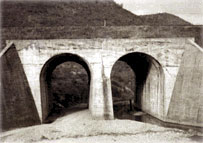Co-editors: Seán Mac Mathúna • John Heathcote
Consulting editor: Themistocles Hoetis
Field Correspondent: Allen Hougland
One of the last acts of the
Clinton administration in January 2001 was the admitting
that its troops had carried out the massacre at No Gun Ri in
1950. Outgoing US Defense Secretary William Cohen announced
plans for a memorial and commemorative scholarships "as a
symbol of our deep regret". It was in June 200 that the
President of South Korea, Kim Dae-jung, called on the US
government to conduct an inquiry into the alleged mass
killing of Korean civilian refugees by US soldiers at a
railway bridge No Gun Ri, South Korea on July 26th,1950.
Recent investigations by the Associated
Press news agency,
started by the journalist Charles HanIey in 1997, into a
number of incidents, have shattered the conventional picture
that all the atrocities in the Korean war were committed
either by the North Koreans or their Chinese allies. The
attack is similar to another massacre carried out later by
U.S. troops in My Lai, Vietnam on March 16th 1968 when U.S.
soldiers went on a rampage, raping, looting and killing as
many as 400 unarmed Vietnamese civilians. According to the AP
investigation, early in the Korean War, U.S. soldiers had
machine-gunned hundreds of helpless civilians, under the
railway bridge at No Gun Ri. The AP investigation is
supported by 12 ex-U.S.. soldiers who have supported the
claims made by South Korean survivors surrounding the
massacre. As well as at least 300 civilians killed in this
attack. another had 100 died in a preceding air attack. U.S.
commanders had ordered units retreating through South Korea
to "shoot civilians" as a defense against disguised enemy
soldiers - itself is a major war crime. Six former members of the 1st
Cavalry Division say that they fired on the refugees trapped
under the bridge at No Gun Ri, and AP found six others who
say said they witnessed the mass killing. Some soldiers
refused to shoot what one described as "civilians just
trying to hide." Another soldier at the scene described the
event as "wholesale slaughter". The massacre had started when
U.S. planes strafed an area near the tunnel where the
refugees were resting. With scores killed, terrified parents
dragged their children into a narrow culvert beneath the
tracks. After this, the survivors were directed into the
bridge underpasses - and after dark, U.S. soldiers opened
fire on them from nearby machine-gun positions. Apparently,
one senior officer, Captain Melbourne Chandler, after
speaking with superior officers by radio, had ordered
machine-gunners from his heavy-weapons company to set up
near the tunnel mouths and open fire after
saying: The bursts of gunfire killed
those near the tunnel entrances first, which left Korean
civilians pulling dead bodies around them for protection.
During three nights under fire, some trapped refugees
managed to slip away, but others were shot as they tried to
escape or crawled out to find clean water to drink. Some
U.S. soldiers said that the massacre at No Gun Ri didn't
have to happen: As the U.S. army was scared that these
refugee columns contained agents from North Korea, the
refugees could have been screened up on the road or checked
out under the bridge. But the US army command took the
decision to massacre them all. When the AP research team
investigated the period of 1950/51, they also found other
alleged war crimes by the United States military, such as
when US jets repeatedly attacked groups of Koreans in
civilian clothes on the suspicion that they harboured enemy
infiltrators. In another strike, US aircraft used firebombs
which killed 300 civilians trapped in a cave. Apparently,
some pilots expressed concern that they were machine gunning
innocent people. In another incident, on a single deadly day
in August 1950, and six weeks into the Korean War, a U.S.
general and other Army officers ordered the destruction of
two strategic bridges as South Korean refugees streamed
across, killing hundreds of civilians, according to ex-GIs,
Korean eyewitnesses and U.S. military documents. Not only have Korean newspapers
have called for a full investigation of all the incidents,
the South Korean defence ministry in Seoul is said to have
heard of nearly 40 similar cases of alleged civilian
killings by US forces. Apparently, more Korean civilians
were killed by US bombing during the war, particularly
during the saturation bombing of Pyongyang in 1952 when, all
in all, some 10,000 litres of napalm and 697 tons of bombs
were dropped, resulting in the killing of some 8,000 people.
Other allegations include: As the real history of the
conflict comes out, we find out that the war - with echoes
of the infamous Gulf of Tonkin incident - itself was
essentially another U.S. instigated conflict: South Korean
troops had attacked the North a year before the Korean war
broke out. The AP research team described this as the
"latest disturbing revelation" about the conflict which
almost led to global war. In one such incident, more than
250 guerrillas from the South are said to have launched an
attack on North Korean villages along the east coast in June
1949. Some reached the town of Wonsan, but all but 50 were
killed in two weeks.

"The hell with all
those people. Let's get rid of all of them"